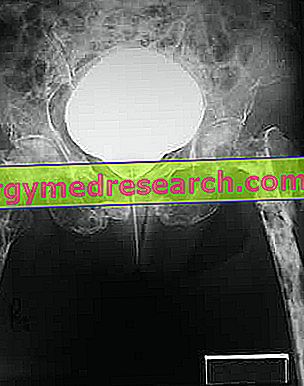Generality
Cystography is a radiological exam that allows us to study the anatomy and functionality of bladder and urethra.

Cystography is based on filling the bladder with an opaque X-ray substance ( contrast medium ), through a small tube (catheter) positioned through the urethra. Subsequently, based on the clinical question, several radiographic images are collected.
What's this
Cystography is a method that uses ionizing radiation to visualize the bladder and urethra. The purpose of this investigation is to study the functionality and morphology of the lower urinary tract .
The examination requires an opacification of the bladder, after having filled the latter, by catheter, with an iodinated contrast medium.
The anatomical evaluation can be associated with micturition cystography (acquisition of radiograms in the bladder emptying phase), for the study of urethral canal obstructions and urinary incontinence.
Retrograde cystography
If the contrast medium is injected directly from the urethra into the bladder, ie with a flow opposite to that of the urine, the cystography is called retrograde.
When and why is it performed?
The cystography allows to observe the filling of the bladder, its repletion and its evacuation, in addition to assessing the urethra during urine excretion.
Indications
The cystography is used to confirm or exclude the presence of some diseases related to the urinary tract, including:
- Reflux of urine from the bladder to the kidney (vesico-ureteral reflux);
- Alterations of the bladder wall (eg diverticula or polyps);
- Bladder stones or tumors;
- Alterations in the shape of the bladder (for example, in patients with long-standing prostatic hypertrophy or neurological bladder);
- Urethral disorders (eg urethral valves).
Taking radiograms during bladder emptying (voiding cystography), then, this test is indicated for the study of alterations in the dynamics of urination, such as obstructions of the urethral canal, urinary incontinence and bladder prolapse.
In male subjects, cystography is useful to investigate disorders associated with prostatic diseases, which can cause delays and difficulty in expelling urine or incomplete evacuation of the bladder.
Complementary examinations
The bladder is an organ that can also be evaluated by ultrasound, endoscopy, computed tomography and magnetic resonance.
How to do it
Cystography is a diagnostic investigation that is carried out directly by the radiologist .
The examination requires an opacification of the lower urinary tract with iodinated contrast medium ; this can be obtained by introducing into the bladder about 250 ml of radiopharmaceutical, through a catheter, which is positioned in the terminal part of the urethra (in man) or in the bladder (in women), in conditions of sterility ( phase of filling ).
When the bladder is full, the radiologist acquires some X-ray images to discover a possible urine reflux. At the end of this procedure, the catheter is removed to perform further radiographs while the patient urinates (men lying on a hip, women standing) and after he has finished urinating.
Other routes of radiopharmaceutical administration
Alternatively, the contrast medium can be administered intravenously (the radiopharmaceutical injected into the vein is excreted by the kidneys) or via suprapubic route, i.e. by injection into the full bladder via the abdominal wall.
During the examination, dynamic images are acquired during retrograde filling (retrograde cystography ) and in the subsequent emptying phase while the patient urinates in a suitable device (voiding cystography ). In practice, the first phase allows to study the morphology, the distensibility of the bladder walls and the possible presence of vesico-ureteral reflux. The voiding phase allows, instead, to study the course and morphology of the urethra.
Depending on the circumstances, one or more micturitions may be necessary to obtain useful diagnostic results.
The duration of the examination varies according to the clinical question (vesico-renal reflux, urinary incontinence, urination difficulties, etc.) and to the findings found during the examination; as a rule, it takes at least 30 minutes for the acquisition of radiograms in different projections.
After cystography, the patient normally remains in the hospital ward for 30 to 60 minutes, for a brief post-procedure observation.
Preparation
- Three hours before the cystography, it is necessary to perform an intestinal cleansing with an enema, with about a liter of warm water. This can be purchased in advance at the pharmacy.
- Cystography generally does not require anesthesia or sedation. After emptying the bladder, the patient is placed in the supine position on the radiological table and the extremity of the penis or genital area in the woman is carefully cleaned.
- In selected cases, the day before the cystography a coverage with antibiotic with urinary excretion may be indicated.
- Any allergies to the contrast agent should be communicated to the doctor before undergoing the examination.
- The patient must carry with him all documentation (eg previous radiological examinations, medical request specifying the indications of cystography, etc.) in some way relevant to the clinical problem in assessment.
Contraindications and risks
Cystography is not normally painful or dangerous.
In the initial phase, the examination is minimally invasive, due to the need to introduce a catheter into the urethra or bladder; the positioning of this device is not a painful operation, but can cause a slight discomfort.
The complications associated with cystography are not common; among these, the most frequent are urinary tract infections and the appearance of small drops of blood in the urine .
Rare allergic reactions to contrast medium are always possible.
Contraindications
The only contraindications to the execution of the cystography are:
- Urinary tract infections in progress;
- Pregnancy (ascertained or suspected);
- Distention of the upper urinary tract (highlighted by a previous ultrasound).
In these cases, it is important to notify the radiologist, who will evaluate the possibility of postponing the exam.
Risks of the method
In the male, positioning of the urethral catheter can cause small lesions against the wall of the urethra. This can cause mild bleeding, usually with spontaneous resolution.
As with other tests that require the introduction of instruments into the urinary tract, there is always the possibility of infections. For this reason, cystography always requires important precautions of asepsis. There is also a risk of damaging the bladder or urethral wall if the injection of the contrast medium is carried out with excessive pressure.
Although it is not a high-risk procedure, any passages of the iodinated contrast medium in the circulatory system (very rare event) can cause allergic reactions to the same radiopharmaceutical.
In this case, some mild (nausea and itching) or moderate disorders (eg profuse vomiting, diffuse urticaria, facial edema and bronchospasm) may occur. These adverse reactions are generally resolved with simple therapeutic measures. Rarely, the iodinated contrast agent used during cystography can lead to severe reactions (hypotensive shock, pulmonary edema and cardio-respiratory arrest).



